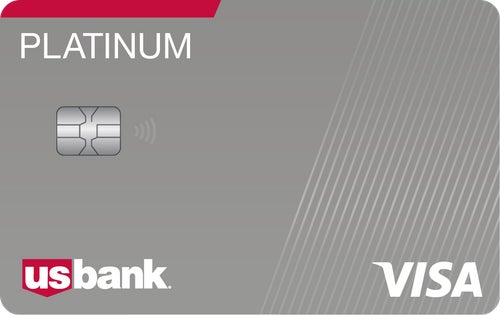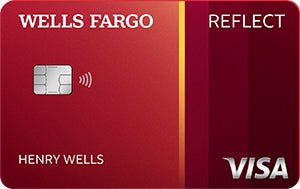The takeaway
The U.S. Bank Visa® Platinum Card is a solid pick for anyone who needs to get rid of existing credit card debt -- but since this card doesn’t earn rewards, its appeal ends here.

U.S. Bank Visa® Platinum Card
- Intro Offer
-
No current offer
- Annual fee
- $0
- APR
- 18.74% – 29.74% (Variable)
- Recommended Credit A credit score is used to indicate an applicant’s credit worthiness and may provide guidance about account eligibility. It does not necessarily guarantee approval for any financial product.
-
670 – 850
Good – Excellent
- Rewards rate
-
N/A This card doesn’t offer cash back, miles, or points
Our take
If you need to eliminate existing credit card debt, the U.S. Bank Visa® Platinum Card could help you do so while avoiding interest charges.
Its 21 billing cycle 0% introductory APR on balance transfers (then 18.74% to 29.74% variable) is one of the longest out there. It also has no annual fee and maintains the industry standard 3% balance transfer fee (with a $5 minimum).
The 0% introductory APR also covers new purchases for 21 billing cycles (then 18.74% to 29.74% variable), but it would be better to choose a different card for this purpose. Since the U.S. Bank Visa Platinum doesn’t earn rewards, after you use your 0% intro APR period to pay off a purchase, you may no longer find this card useful. However, there are other 0% introductory purchase APR credit cards that do offer rewards.
You’ll typically need good to excellent credit to qualify for this card, so if your credit score is below 670, you might want to check out our top picks for fair credit or bad credit, instead.
Pros
Relatively low balance transfer fee
No annual fee
Introductory APR for both purchases and balance transfers
Long introductory offer
Cell phone protection
Cons
No rewards
Limited additional card perks
Recommended for good to excellent credit
Introductory APR
Whether you want to finance a large purchase or transfer a balance from a high-interest credit card, you’ll get 21 billing cycles of introductory interest-free financing as long as you make your minimum payments on time throughout the promotion. After that, both transaction types will be subject to an 18.74% to 29.74% variable APR.
For purchases, the clock starts ticking as soon as you open the account. We recommend paying off any large purchases you make in full before the promotion ends -- that way you won’t accrue interest on your purchases after the 21 billing cycle ends.
The same goes for transferred balances. You get a 60-day grace period within which you can transfer a balance from another account and take advantage of the introductory APR. If you transfer a balance beyond that, the balance will be subject to the regular balance transfer APR of 18.74% to 29.74% variable APR. A balance transfer fee will apply -- 3% of the transaction, with a $5 minimum -- which is typical. Alternatively, cards exist with no balance transfer fee, but they offer shorter introductory APR periods.
To figure out the size of the monthly payment you should make to repay your balance before the 0% introductory APR expires, divide the amount you transferred (plus any fees) by the number of months in the introductory offer, in this case, 21.
So, if you have $5,500 on this card after transferring a balance and paying the balance transfer fee, you’d need to pay roughly $261.90 each month to pay your balance down in full. It’s a good idea to pay slightly more than that number, however, to ensure you can pay it off within the timeframe.
Other features
Like most balance transfer cards, the U.S. Bank Visa Platinum doesn’t offer many extras like a rewards program or welcome bonus, but it does have a few minor additional features.
You’ll get cell phone protection if you pay your monthly bill with the U.S. Bank Visa Platinum Card -- up to $600 if your phone is damaged, stolen or accidentally left behind. You’ll also have the flexibility of choosing your payment due date, and constant access to your credit score through the mobile app or online banking.
Alternative cards
Wells Fargo Reflect® Card
The Wells Fargo Reflect® Card offers a 0% introductory APR on purchases and qualifying balance transfers for 21 months from account opening. You must make your balance transfer within 120 days from account opening to qualify for the introductory rate. After the promotional period ends, your APR jumps up to 18.24%, 24.74%, or 29.99% variable. There is a balance transfer fee of 5% (with a $5 minimum).
Check out our full review for more details about transferring a balance to the Wells Fargo Reflect Card.
Chase Slate Edge℠
The Chase Slate Edge℠ has a slightly lower introductory APR period than the U.S. Bank Visa Platinum, but it also has a bit of an advantage by offering cardholders the opportunity to lower their regular APR by up to 2% per year.
The 0% introductory APR lasts for 18 months for both purchases and balance transfers, then the APR jumps to a 20.49% to 29.24% variable rate. If you pay your bill on time and spend at least $1,000 on the card annually you will automatically be considered for an APR reduction of up to 2% at your account anniversary each year. This offer is valid until your APR reaches 9.74% plus the prime rate.
For more information on how this program works, see our full review of the Chase Slate Edge.
Citi® Diamond Preferred® Card
The Citi® Diamond Preferred® Card* matches the U.S. Bank card’s timeframe to complete a balance transfer. Cardholders get a 0% introductory APR on balance transfers for 21 months (18.24% to 28.99% variable APR thereafter), but its balance transfer fee is a bit pricier.
With a 5% balance transfer fee, and a $5 minimum, you’d be paying a $100 fee on a $2,000 balance transfer. With the balance transfer fee on the U.S. Bank Visa Platinum, you’d only be paying a $60 fee on that same amount. For most people, the additional charge is likely not worth three more months of 0% introductory APR, but if you’re worried about not having enough time to pay down a transferred balance with the U.S. Bank card, this presents another option. For the Citi Diamond Preferred Card, balance transfers must be completed within four months of account opening.
For more information on the parameters of the Citi Diamond Preferred Card, check out our full review.
How the U.S. Bank Visa® Platinum Card compares to other cards
FAQs
Though balance transfer credit cards are technically credit cards, they’re more like a debt-financing tool. They’re better used to pay off existing credit card debt than as a payment method.
A balance transfer is when you take the debt, or balance, you owe on one card account and transfer it to another credit card account. Usually this is done with the goal of saving money by transferring debt from a high-interest account to one with lower or no interest.
While many credit cards allow balance transfers, those primarily designed for the purpose all share one main feature: an introductory 0% APR period on balances transferred to that account, typically applicable to transfers made within the first 60 to 120 days of card ownership. The introductory APR period generally lasts between 12 months and 21 months, giving you a significant period of time to pay off your balance interest-free.
While a few credit cards offer no-fee transfers, most balance transfer cards charge a fee to transfer your debt, usually between 3% and 5%. Broadly speaking, the longer the introductory 0% APR period, the higher the fee, and vice versa. So the best cards without a balance transfer fee have a shorter introductory APR period, and those with the longest introductory APR period have a 3% to 5% transfer fee.
Technically, yes. In some cases, transferring your balance two or three times might even be what’s necessary to finally pay off your debt. But unless you have a firm understanding of how you got into debt in the first place and a plan for getting out of debt, you won’t be working toward a solution.
While transferring your remaining debt to a second balance transfer card may allow you to pay off your balance without monthly interest or a fee, it’s important to note that there are too many variables for multiple balance transfers to be a failure-proof debt strategy.
For example, your card application could be denied, your credit limit could be much lower than you anticipated or your transfer request could be denied. Credit card offers could also change, making it difficult to plan ahead. For this reason I recommend selecting a card that allows you to pay off the full balance after one cycle if possible.
It may take anywhere between 10 days and six weeks to complete a balance transfer, after receiving your new card and cardholder agreement. It’s also important to note that some card issuers, such as Citi, make balance transfers available at their discretion, and could therefore decline a transfer request. And you should probably still pay the minimum on the old card’s balance until you’ve confirmed that the transfer was completed, so you don’t run the risk of fees or penalties.
Methodology
We review the cards that are in the highest demand and offer the best benefits. We scour the fine print so there aren’t any surprises when you open an account. We find the key factors that make a card stand out and compare them to other top cards. That way, readers can opt for a different card with similar features if our pick isn’t right for them. Our reviews are regularly checked and updated to incorporate new recommendations, as well as to reflect changes in offers and the market.
*All information about the Citi Diamond Preferred Card has been collected independently by CNET and has not been reviewed by the issuer.
The editorial content on this page is based solely on objective, independent assessments by our writers and is not influenced by advertising or partnerships. It has not been provided or commissioned by any third party. However, we may receive compensation when you click on links to products or services offered by our partners.




